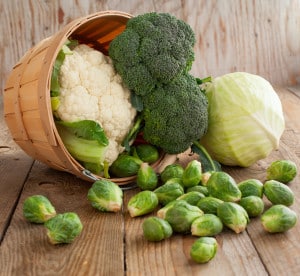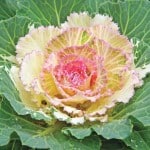 Please note: gardeners in the East Bay (Danville, Concord and Pleasant Hill) should wait until September to plant broccoli.
Please note: gardeners in the East Bay (Danville, Concord and Pleasant Hill) should wait until September to plant broccoli.
Late summer is the ideal time to plant Brassicas (Broccoli, cabbage, kohlrabi, cauliflower and kale). Start them early enough, and they’ll grow late into the fall. These fall plants are hardy, nutritious, delicious and easy to grow. Derived from wild mustard, brassicas are exceedingly nutritious and store high levels of vitamin C in their leaves. They also contain the amino acid glutamine, which is a known anti-inflammatory.
Brassicas need time during warm weather to grow large and leafy before the onset of late fall frosts. The larger the plants become, the greater the size of heads and edible flowering stalks. It is the onset of cool weather that initiates the “heading up”. Plants started in the spring will tend to be smaller, bolt (flower too early), or have small, loose flower heads. As a side note: The biggest cabbages in the Americas are grown in Alaska. The cabbages have the benefit of 21 hours of sunshine in the summer. The record is 105 pounds. (Though the world record is held by Welsh growers at 135 pounds!)
Prepare planting beds with Sloat Loam Builder, 50/50 with the native soil. Apply Agricultural Lime according to directions. Brassicas are lime lovers and do best with a neutral pH of 7. Brassicas are heavy feeders and since the goal is to get them as large as possible, use EB Stone Sure Start at planting time and then feed every 4 weeks with EB Stone Vegetable Food or Maxsea 16-16-16. It doesn’t hurt to give them a watering of fish emulsion now and then either. Water regularly and do not let the soil become overly dry. Have fun!
 Ornamental cabbage and kale (available beginning end of August): Ornamental cabbage and kale provide vibrant fall and winter color with their showy white or reddish-purple leaves. Ornamental kale is a cabbage that does not produce a head. Instead, it produces leaves in a tight rosette. Ornamental kale is used as a bedding plant and looks great with pansies and primroses. It needs well-drained, fertile soil with at least six hours of sun. Ornamental cabbage and kale look full and dramatic in containers. Though not as tasty, ornamental cabbage is still edible and can be used to dress up a dinner plate.
Ornamental cabbage and kale (available beginning end of August): Ornamental cabbage and kale provide vibrant fall and winter color with their showy white or reddish-purple leaves. Ornamental kale is a cabbage that does not produce a head. Instead, it produces leaves in a tight rosette. Ornamental kale is used as a bedding plant and looks great with pansies and primroses. It needs well-drained, fertile soil with at least six hours of sun. Ornamental cabbage and kale look full and dramatic in containers. Though not as tasty, ornamental cabbage is still edible and can be used to dress up a dinner plate.

